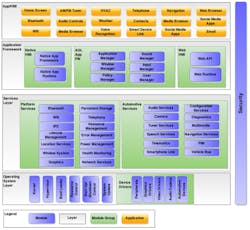Toyota Including Automotive Grade Linux Platform in 2018 Camry
Toyota is taking advantage of the Automotive Grade Linux (AGL) Platform in its 2018 Toyota Camry. AGL will be supporting the inVehicle Infotainment (IVI) systems and not the engine control unit that typically uses an automotive grade RTOS. AGL will be found in instrument cluster, heads-up display, telematics, and advanced driver assistance systems (ADAS). AGL also targets autonomous driving.
The Automotive Grade Linux Platform will be under the hood of the 2018 Toyota Camry.
AGL is an open-source project hosted by The Linux Foundation. The AGL group includes over 100 members that are working toward a de facto industry standard for IVI. It includes a standard services layer that includes many automotive services such as navigation and diagnostics. The system is designed to foster code reuse and to allow products to work on multiple OEM platforms. The idea is to reduce development costs, decrease time-to-market for new products, reduce fragmentation across the industry, and provide developers with a common target platform.
The Automotive Grade Linux (AGL) Platform architecture is based on Linux but it adds a significant number of services targeting inVehicle infotainment support.
The 2018 Camry will be the first car to utilize AGL. The platform is expected to show up in other Toyota and Lexus vehicles in North America as well. “Toyota is an early adopter of Linux and open-source and has been an active member and contributor to AGL for several years,” says Dan Cauchy, executive director of Automotive Grade Linux. “They have been a driving force behind the development of the AGL infotainment platform, and we are excited to see the traction that it’s gaining across the industry.”
The source code is available on the AGL GitHub site. There are board support pages for reference boards like Renesas’ Porter board based on the R-Car M2. There is even support for Raspberry Pi. Of course, these are just platforms to evaluate AGL. Each OEM’s implementation will have additional services and support and AGL does not turn a car into a rolling PC. It simply makes it easier for vendors to acquire and integrate third-party applications. It also makes it easier for car manufacturers to provide support for third party applications that could be installed by the consumer.
AGL is not the only player in this market. In fact, it is more of a newcomer, although its broad support has made it a major player in the IVI market. For example, Blackberry’s QNX has been used in this space in addition to being used in non-IVI automotive applications as well (see “Industrial-Grade RTOSs for the IIoT”). QNX 7.0 has certifications for ISO 26262 ASIL D (the highest level achievable for automobiles), IEC 61508 SIL 3 (for industrial automation systems), and complies with IEC 62304 (life-critical Class III medical devices).
Another open-source player in this space is GENIVI sponsored by the GENIVI Alliance. The Alliance has over 140 member companies. GENIVI is actually a set of components and APIs that includes services like the open source, POSIX-compliant Smart Device Link (SDL) middleware framework supports mobile phone connectivity. It is managed by the SmartDeviceLink Consortium (SDLC). The SDL technology was actually developed by Ford. GENIVI is designed to work with compliant platforms and is relatively agnostic when it comes to the underlying operating system. This can be AGL but it can also be supported on other platforms as well.
The main advantage of AGL is that is brings a common set of services and interfaces to IVI. There is a wide range of services that provide standard front ends to everything from cameras to navigation systems.
About the Author
William G. Wong
Senior Content Director - Electronic Design and Microwaves & RF
I am Editor of Electronic Design focusing on embedded, software, and systems. As Senior Content Director, I also manage Microwaves & RF and I work with a great team of editors to provide engineers, programmers, developers and technical managers with interesting and useful articles and videos on a regular basis. Check out our free newsletters to see the latest content.
You can send press releases for new products for possible coverage on the website. I am also interested in receiving contributed articles for publishing on our website. Use our template and send to me along with a signed release form.
Check out my blog, AltEmbedded on Electronic Design, as well as his latest articles on this site that are listed below.
You can visit my social media via these links:
- AltEmbedded on Electronic Design
- Bill Wong on Facebook
- @AltEmbedded on Twitter
- Bill Wong on LinkedIn
I earned a Bachelor of Electrical Engineering at the Georgia Institute of Technology and a Masters in Computer Science from Rutgers University. I still do a bit of programming using everything from C and C++ to Rust and Ada/SPARK. I do a bit of PHP programming for Drupal websites. I have posted a few Drupal modules.
I still get a hand on software and electronic hardware. Some of this can be found on our Kit Close-Up video series. You can also see me on many of our TechXchange Talk videos. I am interested in a range of projects from robotics to artificial intelligence.




